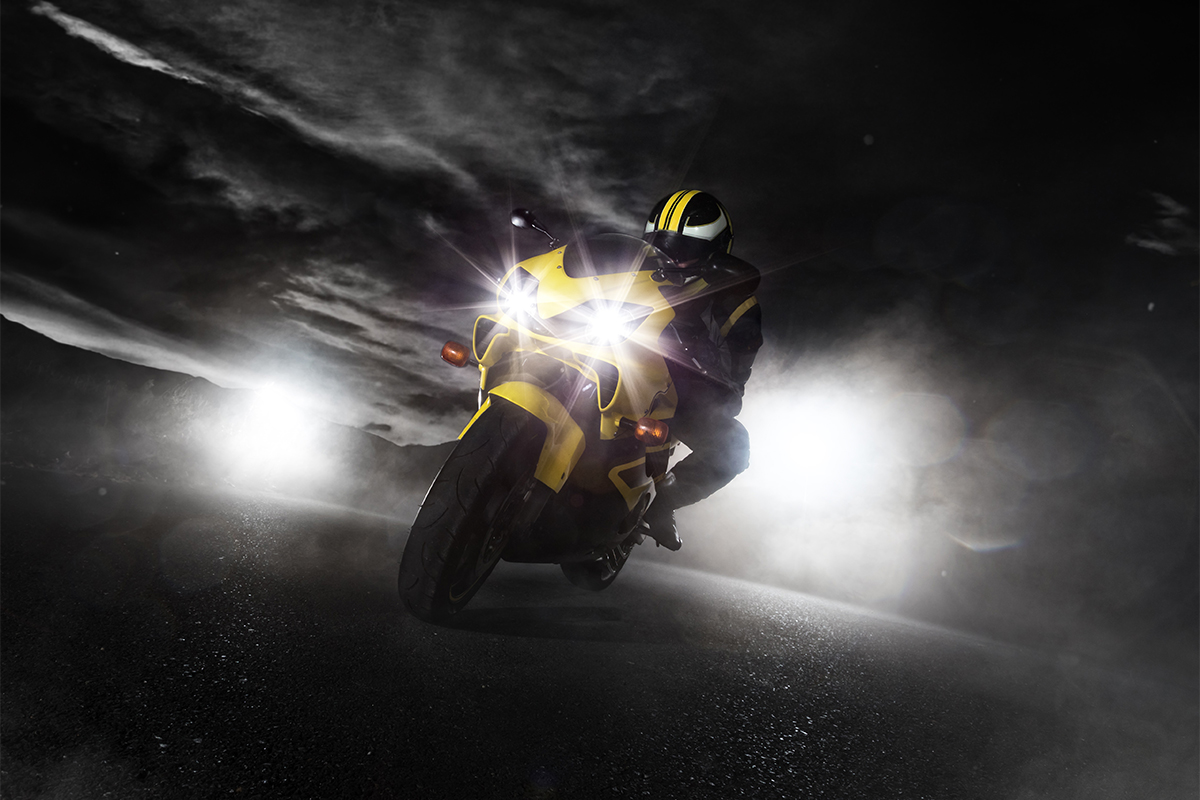Motorcycle lighting
Motorcycle lighting is a critical aspect of motorcycle safety, providing visibility, signaling capabilities, and enhancing overall rider awareness on the road. Properly functioning headlights, taillights, and
side marker lights make the motorcycle more noticeable to other vehicles, pedestrians, and cyclists, especially during low-light conditions or at night. Increased visibility helps prevent collisions and allows other motorists to react in a timely manner. Motorcycle lighting not only makes the motorcycle visible to others but also contributes to the rider's awareness of the surrounding environment. Properly illuminated road surfaces, signs, and potential obstacles improve the rider's ability to navigate safely. Motorcycle lighting must comply with regulatory standards to ensure that the motorcycle is legal and safe for road use. These standards may dictate factors such as light color, intensity, and specific requirements for different types of lights.
Motorcycles are equipped with various types of lights, each serving specific functions to enhance visibility, communicate the rider's intentions, and ensure safety on the road.
Headlights
Headlights on motorcycles are indispensable for rider safety. They provide essential illumination, enhance visibility, communicate the presence of the motorcycle to others, aid in hazard identification, and contribute to overall safe riding conditions, especially in low-light and nighttime situations. Riding a motorcycle at night poses additional challenges due to reduced visibility. Headlights provide the necessary illumination for the rider to navigate the road, identify potential obstacles, and maintain safe riding conditions after sunset. Motorcycles are smaller in size compared to cars and trucks. Headlights help compensate for the reduced size, making motorcycles more visible to other road users, particularly in situations where they might otherwise go unnoticed.
Taillights
Taillights on motorcycles are positioned at the rear of the bike and serve as crucial indicators of the motorcycle's presence to vehicles approaching from behind. The primary function of motorcycle taillights is to enhance the rear visibility of the bike. They are designed to be easily seen by drivers of vehicles following the motorcycle, contributing to overall road safety. Taillights are activated when the motorcycle is in operation, serving as a clear indication of the bike's presence on the road. This is especially important in various traffic conditions, including low-light situations, dusk, or nighttime riding. In adverse weather conditions, such as rain or fog, visibility on the road is reduced. The use of taillights ensures that the motorcycle remains visible to following vehicles, even in challenging weather conditions. In addition to serving as regular running lights, motorcycle taillights often function as brake lights. When the rider applies the brakes, the intensity of the taillights increases, signaling to vehicles behind that the motorcycle is slowing down or coming to a stop.
Brake lights
Brake lights serve as a form of communication between the motorcycle rider and other road users. This illumination serves as a clear and immediate signal to following vehicles, indicating a decrease in speed or a complete stop. When the rider applies the brakes, the illuminated brake lights immediately convey the message that the motorcycle is slowing down or coming to a stop. By providing a visual cue to following drivers that the motorcycle is slowing down, brake lights give them crucial information to react appropriately and avoid colliding with the rear of the motorcycle. The rapid response of illuminated brake lights helps other drivers gauge the rate at which the motorcycle is slowing down, allowing for timely and appropriate reactions.
Turn signals
Turn signals on motorcycles are essential devices used to indicate the rider's intention to turn or change lanes. They are typically located at both the front and rear of the motorcycle and are designed to flash in the direction of the intended turn. Turn signals contribute to effective communication between the motorcycle rider and other road users. Clear and visible turn signals provide a visual indication of the rider's planned actions, reducing confusion and enhancing overall road safety. By activating the turn signal, the rider signals to other road users, including drivers and pedestrians, that they are about to change the motorcycle's direction. Turn signals flash in the direction of the intended turn or lane change. This directional flashing provides specific information to other road users about the side of the motorcycle on which the turn will occur.
Daytime running lights (DRLs) on motorcycles are lower-intensity lights specifically designed to remain illuminated while the motorcycle is in operation during daylight hours. These lights are intended to make the motorcycle more noticeable to other road users, reducing the risk of accidents. The use of DRLs reduces the risk of collisions, particularly in situations where visibility might be compromised. They serve as a proactive safety feature, alerting other road users to the motorcycle's presence well before potential conflicts may arise. This is especially useful in situations where the ambient light is sufficient, and using full headlights may not be necessary or may cause discomfort to other road users. In some regions, traffic regulations or safety standards may require or recommend the use of DRLs on motorcycles.
Marker lights
Marker lights on motorcycles are additional lights strategically placed to enhance the motorcycle's visibility from the side. These lights play a specific role in improving overall side visibility, contributing to safety on the road. While headlights and taillights primarily focus on front and rear visibility, marker lights ensure that the motorcycle remains noticeable when viewed from the side, reducing the risk of side collisions. Marker lights are typically positioned on the sides of the motorcycle. Their placement may vary, but it is often designed to create a well-distributed illumination along the sides, making the motorcycle more visible to other road users, especially in low-light conditions.
Fog lights on motorcycles are designed to cut through dense fog and provide better visibility close to the ground. Although less common on motorcycles compared to cars, some riders choose to install fog lights for improved visibility in specific riding conditions. Fog lights are particularly useful in specific riding conditions where visibility is compromised by fog, mist, or other atmospheric conditions. Fog lights are often mounted lower on the motorcycle to illuminate the road close to the ground. This positioning helps in providing better visibility of the road surface, obstacles, and potential hazards that may be hidden by the fog.
License plate lights on motorcycles serve the essential function of illuminating the motorcycle's license plate. Positioned at the rear of the motorcycle, illuminated license plates prevent legal issues that may arise from obscured or unreadable plates, especially during low-light conditions or at night. Their illumination ensures that the license plate remains visible, contributing to the overall visibility of the motorcycle to other road users and law enforcement.
Auxiliary lights
Motorcycle auxiliary lights refer to additional
lighting fixtures that riders choose to install on their motorcycles to enhance visibility. These lights serve various purposes and can include spotlights,
driving lights, or
off-road lights, depending on the rider's preferences and intended use. Spotlights are focused, high-intensity lights that project a narrow beam of light over a long distance. Driving lights are designed to supplement the motorcycle's existing headlights. They provide a broader and more extended beam of light, improving visibility over a larger area. Off-road lights are specifically designed for use during off-road adventures. They are rugged, durable, and capable of providing intense illumination for navigating through trails, dirt paths, or challenging terrains where standard headlights may be insufficient.
Emergency flashers
Some motorcycles come equipped with emergency flashers, also known as hazard lights or four-way flashers, which can be activated to create a rapid and attention-grabbing flashing pattern. These lights serve a specific purpose in emergency situations to signal urgency or alert other road users to a potential hazard. When activated, emergency flashers on motorcycles create a rapid and distinctive flashing pattern. This pattern is designed to quickly capture the attention of other road users and signal that the motorcycle is in an emergency or hazardous situation.
LED motorcycle lighting
The impact of technology on motorcycle lighting has been substantial, leading to advancements that enhance safety, visibility, and overall riding experience. The widespread adoption of
LED technology has revolutionized motorcycle lighting. The high energy efficiency of LED lights translates to reduced power consumption, which is crucial for motorcycles with limited electrical capacity. LEDs are solid-state devices, making them more resistant to vibrations and shocks. This durability is especially beneficial for motorcycles that may encounter rough road conditions. The longevity of LED lights contributes to overall maintenance cost savings for motorcycle owners. LED technology allows for compact and lightweight designs, making it easier to integrate lighting elements into the sleek and often limited spaces on motorcycles. This contributes to a more streamlined and modern aesthetic. LEDs produce bright and clear light, enhancing visibility for both the rider and other road users. This is particularly important for motorcycles, where visibility plays a critical role in safety. LEDs provide instantaneous illumination, reaching full brightness almost instantly. This quick response time improves safety, especially during sudden braking or signaling situations. LED technology facilitates the incorporation of various color options, enabling customization and personalization for motorcycle enthusiasts. Some motorcycles equipped with LED headlights incorporate adaptive lighting systems that adjust the light pattern based on factors like speed, lean angle, and road conditions. LED lighting systems can be integrated with motorcycle electronics for advanced features. For example, LED turn signals can be synchronized with the motorcycle's electronics for sequential signaling.
Advanced motorcycles often come equipped with adaptive headlights, a feature designed to enhance visibility and safety, especially during curves and turns. Adaptive headlights employ various sensors and technologies to adjust the direction and intensity of the light beam based on dynamic factors. Motorcycles with adaptive LED headlights are equipped with sensors that continuously monitor various parameters. Common inputs include the motorcycle's speed, lean angle, steering input, and the surrounding environmental conditions. As the motorcycle's speed changes, the adaptive headlights can dynamically adjust the light beam. For instance, at lower speeds or during stops, the headlights may illuminate a broader area to enhance visibility in urban settings. At higher speeds, the focus may shift to provide a longer throw of light on the road ahead. One of the key features of adaptive headlights for motorcycles is the ability to compensate for the motorcycle's lean angle during turns. Traditional headlights are fixed in position, but adaptive headlights can pivot or swivel in the direction of the lean, ensuring that the illuminated area aligns with the rider's line of sight through the turn. The adjustment of the light beam during turns significantly improves visibility for the rider. This is especially crucial when navigating curves and winding roads where traditional headlights may not effectively illuminate the path due to the bike's lean angle. Some motorcycles may have dedicated cornering lights that activate in conjunction with the lean angle. These lights are designed to cast additional illumination in the direction of the turn.
Advanced lighting control
Motorcycles are equipped with advanced control systems that monitor various parameters, including lighting conditions. These systems can automatically adjust the brightness of instrument clusters, dashboards, and other displays based on ambient lighting, providing optimal visibility to the rider. Smart headlights incorporate features such as automatic high-beam control, adaptive lighting, and dynamic beam patterns. These systems use sensors and cameras to detect oncoming traffic, adjust the beam accordingly, and provide optimal illumination without causing glare to other road users. Adaptive headlights are often part of larger systems known as adaptive front-Lighting systems (AFS). AFS integrates various technologies, including adaptive headlights, to optimize the illumination pattern based on real-time conditions and the rider's behavior. Certain motorcycles incorporate weather-adaptive lighting systems that automatically adjust the intensity and pattern of lights based on weather conditions. This feature improves visibility during adverse weather, such as rain or fog. Some motorcycles now feature wireless connectivity that allows riders to control lighting functions using smartphone apps. This includes adjusting brightness, changing colors, and accessing advanced lighting settings.
Customization and aesthetics
Advancements in technology have significantly facilitated the customization of motorcycle lighting, providing riders with a wide range of options to personalize the look of their motorcycles. LED technology supports futuristic and forward-looking designs. Manufacturers can experiment with shapes and lighting arrangements that contribute to a modern and progressive appearance, aligning with evolving design trends. Aftermarket LED kits have become popular for motorcycle customization. The use of LED technology allows riders to choose their preferred color or create dynamic lighting effects. Color-changing LED lights are often used for accent lighting, adding a personalized touch to the motorcycle's appearance. Advanced programmable lighting systems enable riders to customize and control the behavior of their motorcycle lights.
LED strips or pods can be strategically placed on motorcycles to create underglow or accent lighting. These lights are often customizable and add a stylish and eye-catching element to the motorcycle, especially when riding at night. Manufacturers can implement features such as sequential turn signals, dynamic brake lights, and adaptive lighting patterns, adding a layer of sophistication to the motorcycle's lighting system.















